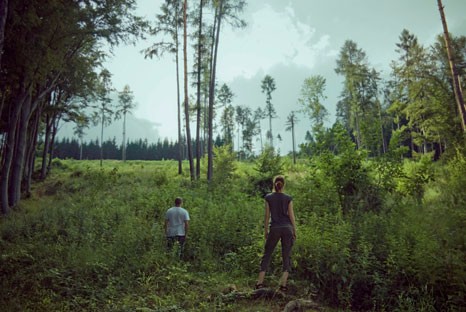Tandem diStruktura
Face to Face
Face to Face series is wide-ranging project that explores the external field of our relationship and a position of our intimate space in public space. Partakers of these symbolic presentations are artists, forming their intimate space, and a new born nature, destroyed landscapes and chaos and flux of cities in today’s increasingly globalized society.
As a result of this juxtaposition between intimate and a public we can witness a process of individuation, a process of singling out an entity or emphasizing someone’s individuality.
The perspective of these scenes focuses a spectator’s view in a way that suggests a gaze “from above”- a bird’s eye perspective that simultaneously offers orientation makes you experience vastness and implies freedom and it can be defined as a fundamental instrument of control and hegemony. Yet the persons that inhabit these landscapes remain subjugated by the Nature, with its deep symbolic connotation, referring to cosmic solitude of a man in an endless world of appearances. A central inspiration can be found in works of romanticist painters of 19 century, especially in Caspar David Friedrich’s paintings of landscapes filled with lonely figures, meaningless in front of the nature. Following his inner impulses, he used to glorify strength and beauty of the nature providing a spiritual significance. In such way he has created a new type of a painting – “landscape as an icon of a nature”, where landscape stops to be just a decoration, a reflection of our surroundings, and starts to describe our inner life and offers new meanings such as human comprehension of nature and a relation between a man and environment.
Diving into the world of emotions, imaginations and sensual senses C. S. Friedrich managed to convert a world of material sensations into an area of supernatural by creating landscapes that reflect emotional reactions on natures’ experiences. It is, in fact, a confession of extraordinary state of mind caused by nature.
The perspective of these scenes focuses a spectator’s view in a way that suggests a gaze “from above”- a bird’s eye perspective that simultaneously offers orientation makes you experience vastness and implies freedom and it can be defined as a fundamental instrument of control and hegemony. Yet the persons that inhabit these landscapes remain subjugated by the Nature, with its deep symbolic connotation, referring to cosmic solitude of a man in an endless world of appearances. A central inspiration can be found in works of romanticist painters of 19 century, especially in Caspar David Friedrich’s paintings of landscapes filled with lonely figures, meaningless in front of the nature. Following his inner impulses, he used to glorify strength and beauty of the nature providing a spiritual significance. In such way he has created a new type of a painting – “landscape as an icon of a nature”, where landscape stops to be just a decoration, a reflection of our surroundings, and starts to describe our inner life and offers new meanings such as human comprehension of nature and a relation between a man and environment.
Diving into the world of emotions, imaginations and sensual senses C. S. Friedrich managed to convert a world of material sensations into an area of supernatural by creating landscapes that reflect emotional reactions on natures’ experiences. It is, in fact, a confession of extraordinary state of mind caused by nature.















